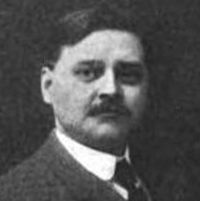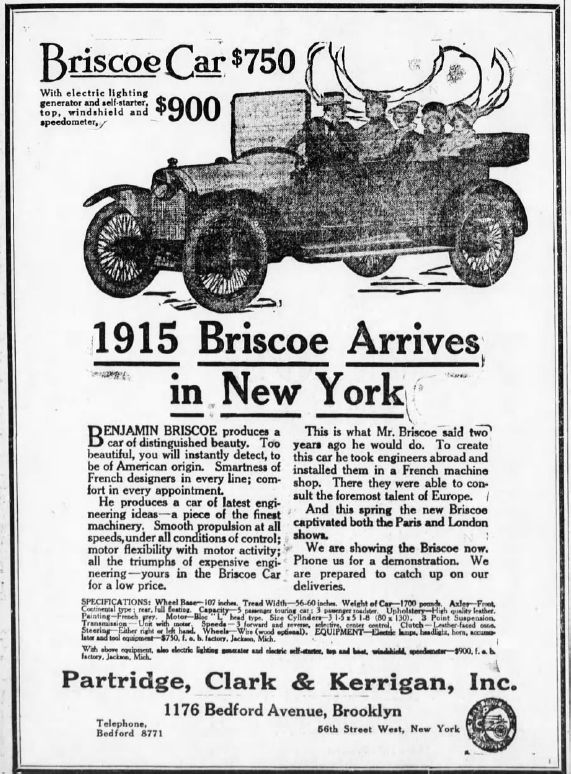 Benjamin Briscoe was as well known in the early automobile world as Prince Harry is today. In the early days of the industrial revolution Detroit emerged as one of the biggest hotbeds of heavy industry in the USA. America’s greatest industry was railroads, and the largest rail car (wagon) manufacturers were concentrated in Detroit, as were other heavy metal industries like stoves and the like. In a metal-intensive environment it’s no surprise that the Briscoe brothers’ sheet metal business thrived.
Benjamin Briscoe was as well known in the early automobile world as Prince Harry is today. In the early days of the industrial revolution Detroit emerged as one of the biggest hotbeds of heavy industry in the USA. America’s greatest industry was railroads, and the largest rail car (wagon) manufacturers were concentrated in Detroit, as were other heavy metal industries like stoves and the like. In a metal-intensive environment it’s no surprise that the Briscoe brothers’ sheet metal business thrived.
Then disaster struck. The bank holding their accounts folded. That kind of thing happened all too often in those days before the FDIC. The Briscoes had a thriving and profitable business but they couldn’t make payroll. So Ben hopped on a train and went straight to the top: J. P. Morgan. His business was steady and profitable, and its location at a port enabled cheap and efficient shipping of his products to New York and the other major cities. Oh, and he also agreed to buy all his metal from the House of Morgan’s latest creation: U. S. Steel.
So, flush with a $100,000 loan (huge money for those days) Ben Briscoe returned triumphantly to Detroit. Not only could they survive, they could expand.
Perfect timing: just around that time the Olds Detroit factory burned to the ground. Olds was the first automobile company of any substance: it sold more than ten times the number of cars than its next competitor. Ransom Olds also had a plant in Lansing, but that was running at full capacity making stationary engines (his earlier business). So he turned to his Detroit business acquaintances to help out. Henry Leland made transmissions, the Dodge brothers made engines… and the Briscoes made fuel tanks, fenders and radiators. Olds soon was forced out of his own company by the infamous rich man’s kid, Fred Smith, and started a new company, REO, using his initials.
While this was happening, one of Briscoe’s customers, David Buick, ran into financial trouble. He told Briscoe he only needed $3,500 and he would repay it soon (the first time anybody ever said that, of course). Briscoe wanted to help a friend, but didn’t want to be taken advantage of. So he made an innovative agreement: if the loan got repaid, no problem. But if Buick did not repay the loan, Briscoe would take over his company.
In the meantime, after Olds left the Olds Motor Works, Jonathan Maxwell, the leading techie behind the automobile side (as opposed to engines, which Olds led) also wanted out from under the Fred Smith regime. So he left to join Northern, another startup. Then he also approached Briscoe: how about starting a new automobile company, just the two of them?
Briscoe was torn: should he even enter the automobile business, or stick with same old, same old, which paid the bills and offered security? Olds chose to follow the dream, surrendering security, and look where he ended up. Same with Buick: struggling along, and it didn’t seem likely he was going to repay on time. Same old same old may sound boring but twenty years later it will still keep a nice roof over your head. But the excitement of the new… ahh, how can you not be enticed by the thrill?
Next question: if he entered the auto business, with whom should he do it? Buick was a friend but unproven. Maxwell was well proven but a wandering star. Both was not an option. So Briscoe chose Maxwell, and that’s how the Maxwell-Briscoe company got started.
Having chosen to partner with Maxwell, Briscoe had no need for Buick. Through the old “one things leads to another” routine, Buick’s loan ended up being held by Jim Whiting of the Flint Wagon Works. Whiting, as we know, soon handed Buick over to Billy Durant.
Ben Briscoe, in the meantime, kept in touch with J. P. Morgan, eventually being matched up with partner George Perkins. Perkins is an interesting fellow (maybe I’ll do a post about him, he’s that interesting). Perkins was fresh off creating International Harvester, a combination of two feuding implement makers, so Briscoe approached him with the notion of an automobile combination.
Perkins was open to the idea, and the first person Briscoe, all excited, mentioned the idea to was none other than Billy Durant. Billy was friends with everybody, and everybody knew if you wanted to get something done, Billy was your man. So they got Henry Ford and Ranny Olds together and the four of them paid the House of Morgan a visit. The unconventional and informal Billy did not garner any respect from the self-important and staid Big Money set, and that combination hit the skids.
So Briscoe and Billy figured they can do it on their own. However, Briscoe was still tied to Morgan’s apron strings, and when they got wind of those plans they made it clear on no uncertain terms that any combination with that Durant fellow was off the table.
So the two friends went their separate ways: Billy started General Motors and began buying anything with a front door that opened. Briscoe thought that sounded like fun, so he started U. S. Motors and did the same, starting with the sheet metal business and Maxwell-Briscoe. Comeback! tells Billy’s side of the story.
The U. S. Motors story starts out similarly, but ends quite differently: in September, 1912 the company filed for bankruptcy, Briscoe resigned and the two brothers went to France to start an automobile business there.
Walter Flanders (you will read a post about him later, quite a remarkable character, too) was brought in by the receivers to rescue U. S. Motors. He slashed everything, keeping only the original Maxwell-Briscoe business, renaming it simply Maxwell. And when Walter Chrysler parted ways with Billy he ended up as Maxwell’s CEO and, of course, it wasn’t long before he changed the name of the company to Chrysler.
Briscoe eventually returned in 1914 and started another car company, its ad shown below. However, the magic was gone and Ben Briscoe faded into gentle and comfortable obscurity–not poor but not Henry Ford or Billy Durant, either.
